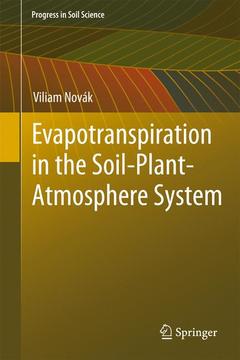Description
Evapotranspiration in the Soil-Plant-Atmosphere System, 2012
Progress in Soil Science Series
Author: Novak Viliam
Language: English
Subjects for Evapotranspiration in the Soil-Plant-Atmosphere System:
Approximative price 105.49 €
In Print (Delivery period: 15 days).
Add to cartPublication date: 07-2014
256 p. · 15.5x23.5 cm · Paperback
Approximative price 105.49 €
In Print (Delivery period: 15 days).
Add to cartPublication date: 06-2012
256 p. · 15.5x23.5 cm · Paperback
Description
/li>Contents
/li>Biography
/li>Comment
/li>
Evapotranspiration and its components (evaporation and transpiration) as a process is one of the basic terms of Earth's water balance; its importance is accented by the fact that transpiration is the vital element of the biomass production process. The second important property of evapotranspiration is its extreme consumption of solar energy, thus controlling the temperature of the atmosphere and creating favourable conditions for life. Evapotranspiration as an energy consuming process is also the connection between the energy and mass cycles of the Earth. Evapotranspiration is a process performing in the Soil?Plant ?Atmosphere System (SPAS); therefore this book is presenting and quantifying it as a catenary process, describing transport of water in the soil, including root extraction patterns and methods of its evaluation. Transport of water through the plant and from the canopy to the atmosphere is also described and quantified. A variety of evapotranspiration (and its componentsevaporation and transpiration) calculation methods are described, starting from empirical methods up to the most sophisticated ones based on the solution of the transport equations of water and energy in the SPAS. The most important (and widely used) calculation method - modified Penman?Monteith method is described in details, ready to be used with data in the book only. Water balance method of evapotranspiration estimation as well as sap flow method description can be found in the book as well. The book can be used by hydrologists, biologists, meteorologists and other specialists as well as by ecology students.
Key themes: soil hydrology ? evapotranspiration ? hydropedology? plant physiology ? water movement in soils ? evaporation ? transpiration
Dr. Viliam Novák is a water resources scientist at the Institute of Hydrology of the Slovak Academy of Sciences in Bratislava (Slovakia).
-Evaporation process and its basic properties.-
-Evaporation and kinetic theory of fluids.-
-Water balance and water cycle.-
-Energy balance of the evaporation area.-
Soil–plant–atmosphere system.-
-Water.-
-Soil and other parts of Earth surface.-
-Basic soil properties.-
-Canopy.-
-Atmosphere.-
Evaporation from different surfaces.-
-Evaporation of intercepted water.-
-Evaporation from free water surface.-
-Evaporation from snow and ice.-
-Evaporation from urban territories.-
-Transpiration.-
-Potential evapotranspiration.-
Transport of water and energy in the boundary layer of atmosphere.-
-Meteorological characteristics of the boundary layer of atmosphere vertical distribution.-
-Coefficients of heat and water vapour transport in the SPAC system.-
Movement of water in soil during evaporation.-
-Bare soil evaporation.-
-Soil water content profiles during bare soil evaporation.-
-Transport of water and heat in an unsaturated porous media.-
-Soil water transport quantification in isothermal conditions.-
-System of equations describing the transport of heat and water in porous media.-
Movement of water in the soil root zone during transpiration.-
-Water in a soil root zone.-
-Roots system.-
-Field measurements.-
-Methods of soil water uptake patterns calculation.-
-Mesoscopic approach to water uptake by plant roots.-
The role of plants in transport processes in the Soil – Plant – Atmosphere system.-
-Transport of water from soil through plant to the atmosphere and its quantification.-
-Transpiration control by stomata.-
-Canopy and stomata conductivity during transpiration.-
Evapotranspiration and soil water.-
-Evapotranspiration and soil water content.-
-Evapotranspiration and soil–water potential.--Transpiration and uptake of water by roots during combined water and salinity stress.-
Methods of evapotranspiration estimation.-
-Evapotranspiration measurement.-
-Methods of evapotranspiration calculation.-
-Micrometeorological methods of evapotranspiration estimation.-
-Measurement and evaluation of sap flow data in trees and stands to evaluate transpiration rate.-
Evapotranspiration components structure.-
-Potential evapotranspiration components structure.-
-Components of evapotranspiration: Daily and seasonal courses.-
Combination method of daily evapotranspiration calculation.-
-Distribution of land according to the type of evaporating surface.-
-Net radiation of evaporating surfaces.-
-Potential evapotranspiration of homogeneous surfaces.-
-Potential evapotranspiration components.
-Actual evapotranspiration calculation.-
Estimation of regional evapotranspiration using remote sensing data.-
-Energy balance method.-
-Regional evapotranspiration estimation using complementary relationship.




